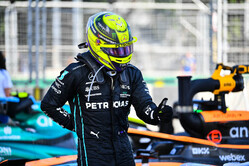


16/06/2022
NEWS STORY
 A technical directive has been issued by the FIA to give guidance to the teams about the measures it intends to take to tackle the problem of porpoising.
A technical directive has been issued by the FIA to give guidance to the teams about the measures it intends to take to tackle the problem of porpoising.
The move follow's last weekend's Azerbaijan Grand Prix during which the phenomenon of porpoising (aerodynamic oscillations) of the new generation of F1 cars, and the effect of this during and after the race on the physical condition of the drivers was once again visible
As the governing body of the sport, the FIA has decided that, in the interests of the safety, it is necessary to intervene to require that the teams make the necessary adjustments to reduce or to eliminate this phenomenon.
The measures the FIA intends to take include:
1. Closer scrutiny of the planks and skids, both in terms of their design and the observed wear
2. The definition of a metric, based on the car's vertical acceleration, that will give a quantitative limit for acceptable level of vertical oscillations. The exact mathematical formula for this metric is still being analysed by the FIA, and the Formula 1 teams have been invited to contribute to this process.
In addition to these short-term measures, the FIA will convene a technical meeting with the teams in order to define measures that will reduce the propensity of cars to exhibit such phenomena in the medium term.
The FIA has decided to intervene following consultation with its doctors in the interests of safety of the drivers. In a sport where the competitors are routinely driving at speeds in excess of 300km/h, it is considered that all of a driver's concentration needs to be focused on that task and that excessive fatigue or pain experienced by a driver could have significant consequences should it result in a loss of concentration.
In addition, the FIA has concerns in relation to the immediate physical impact on the health of the drivers, a number of whom have reported back pain following recent events.
It's understood that new limits on the oscillations will be set before FP3 and if teams cannot provide a set-up deemed to be safe they will be forced to increase the ride height on their cars by 10mm.
Should cars still be found to be oscillating over the set limit they would face disqualification.